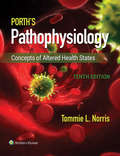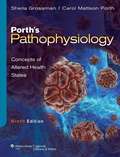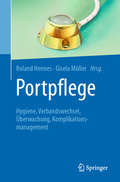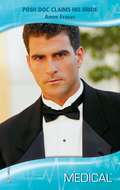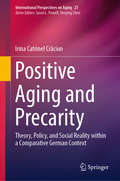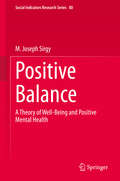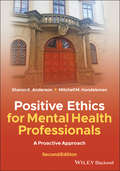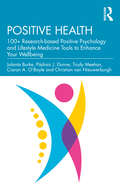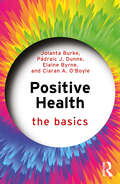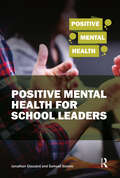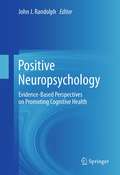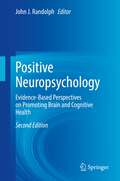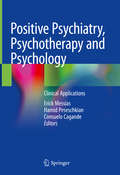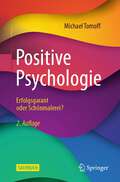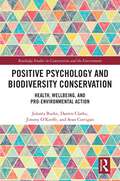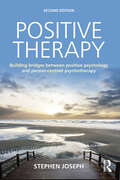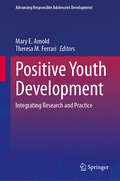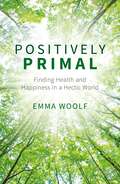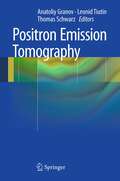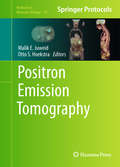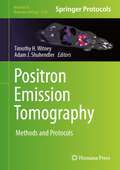- Table View
- List View
Porth's Pathophysiology: Concepts of Altered Health States (Coursepoint Ser.)
by Tommie L. Norris Rupa LalchandaniPublisher’s Note: Products purchased from 3rd Party sellers are not guaranteed by the Publisher for quality, authenticity, or access to any online entitlements included with the product. The 10th edition of Porth’s Pathophysiology: Concepts of Altered Health Statescontinues a legacy of excellence by providing comprehensive, nursing-focused coverage designed to help grasp both the physical and psychological aspects of altered health. The book’s unique emphasis on “concepts" of altered health states, as opposed to factual descriptions of diseases and disorders, helps students grasp both the physical and psychological aspects of altered health. Porth’s Pathophysiology: Concepts of Altered Health States Tenth Edition Tommie L. Norris, DNS, RN Meet today’s clinical challenges with the trusted authority in pathophysiology Make the most of your pathophysiology course and master the knowledge to ensure clinical success. Trusted for more than 30 years and updated to reflect today’s nursing challenges, this engaging text makes complex concepts accessible and helps you easily and confidently grasp normal body function, the effects of disease on body systems, and the body’s ability to compensate and adapt. This edition also considers the many technological advances that allow healthcare providers to diagnose earlier and with more accuracy. Highlights of the Tenth Edition Approachable presentation builds understanding from basic to advanced concepts and defines key terms as you progress. “Chunked” content keeps you focused on the most critical information and helps you review salient points efficiently. Unit-Opening Case Studies, which are revisited in one or more chapters in the unit, bring pathophysiology to life and equip you for success in clinical practice. Approximately 1,000 vibrant illustrations clarify the clinical manifestations of diseases and disease processes. Understanding boxes break physiologic processes and phenomena into their sequential parts, providing insight into the many opportunities for disease to disrupt the processes. Key Points boxes and In Summary sections reduce the need for memorization and help you incorporate important points into broader conceptual units. NEW!Pediatric Considerations and Geriatric Considerations boxes in each chapter specify how the chapter content applies to these two special populations. NEW!Concept Mastery Alerts explain topics that students can find confusing. Review Exercises at the end of each chapter test your retention and identify areas for further study. References provide fast, efficient access to normal laboratory values in both conventional and SI units, as well as a comprehensive glossary. Narrated animations referenced by icons in the text and available online enhance your understanding of the most challenging and clinically relevant concepts.
Porth's Pathophysiology: Concepts of Altered Health States (Ninth Edition)
by Sheila Grossman Carol PorthSucceed in your pathophysiology text with this 9th edition of Porth's Pathophysiology: Concepts of Altered Health States. Captivating and easy-to understand, this proven book provides comprehensive, nursing-focused coverage designed to help you grasp both the physical and psychological aspects of altered health. Master the most clinically relevant and difficult to understand disorders with advanced 3D narrated animations. Prepare for clinical practice with 14 unit-opening case studies that put a real face on pathophysiology and help you relate the clinical presentation to the underlying pathophysiology. Master the information you need for success in your career with the unparalleled coverage of disease processes that make this text the most comprehensive pathophysiology text available. Increase your understanding of key concepts with the full-color art program that illustrates the clinical manifestations of diseases and disease processes. Find the information you need fast with the book's consistent presentation of each disease, with detailed coverage of pathophysiology, clinical manifestations, and evaluation and treatment. Reinforce your understanding of key content with chapter-ending review exercises. Develop a strong understanding of pathophysiology concepts with the easy-to-follow narrative that builds concepts on one another, defines words as content is presented, and reviews concepts from physiology, biochemistry, physics, and other sciences along the way. Deepen your understanding by pausing and reviewing salient points using the easily-identified section-opening Objectives and section-ending Summaries. Retain and apply text information using Key Concepts Boxes help you incorporate key information into a larger conceptual unit, rather than memorizing a string of related and unrelated facts. Easily access useful references including lists of common suffixes and prefixes, normal laboratory values in both conventional and SI units, and a comprehensive glossary. Take your understanding beyond the book with anytime, anywhere access to the fully searchable eBook online.
Portpflege: Hygiene, Verbandswechsel, Überwachung, Komplikationsmanagement
by Roland Hennes Gisela MüllerUmfassende und professionelle Pflege von Menschen mit Ports! Dieses Buch bietet Pflegekräften und medizinischen Berufsgruppen umfangreiches Wissen für die Versorgung von Menschen mit Ports. Beginnend mit der Auswahl und der Indikation für eine Portanlage, über den Verbandswechsel und den Hygienerichtlinien, bis zum alltäglichen Handling – hier finden Sie Expertenwissen auf höchstem Niveau! Die Autoren kommen aus unterschiedlichen Berufsgruppen und zeigen, dass eine gute interprofessionelle Zusammenarbeit für eine erfolgreiche Behandlung von Patienten mit Port unabdingbar ist.
Posh Doc Claims His Bride
by Anne FraserWhen Meagan starts her stint as a doctor on Scotland's Western Isles, the last person she expects to see is the man who broke her heart six years earlier, Dr. Cameron Stuart. Or, as the locals know him, Lord Grimsay!Meagan is still reeling from that discovery when she finds out that not only is Cameron a lord, he's also a single father! In the past Cameron was forced to do his duty. Now fate has given him a chance to follow his heart and build a life with Meagan. But will she agree to be the new Lady Grimsay?
Posh Doc, Society Wedding
by Joanna NeilThe return of Glenmuir's handsome laird causes quite a stir in the small Highland community. Ross Buchanan will have to work hard to win over the locals, especially Dr. Izzy McKinnon. Though her heart melts with each stolen kiss, Izzy knows that Ross is the one man she can't fall for...Avoiding Ross is easier said than done, especially as they have to work together. But this New Year's Glenmuir Castle is set for a celebration to remember--Izzy has won Ross's heart, and he's determined to make her his New Year bride!
Positive Aging and Precarity: Theory, Policy, and Social Reality within a Comparative German Context (International Perspectives on Aging #21)
by Irina Catrinel CrăciunThis book explores positive aging through the lens of precarity, aiming to ground positive aging theories in current social contexts. In recent years, research on aging has been branded by growing disagreements between supporters of the successful aging model and critical gerontologists who highlight the widening inequalities, disadvantages and precarity that characterize old age. This book comes to fill a gap in knowledge by offering an alternative view on positive aging, informed by precarity and its impact on projections concerning aging.The first part of the book places aging in broader theoretical and empirical context, exploring the complex links between views on aging, successful aging theories, policy and social reality. The second part uses results from a qualitative research conducted in Germany to illustrate the dissonance between successful aging ideals and both negative and positive views on aging as well as aging preparation strategies inspired by precarity. Findings from this section provide a solid starting point for comparisons with countries that are both similar and different from Germany in terms of welfare regimes and aging policies. The final part of the book discusses the psychological implications of these findings within and beyond the German case study and outlines potential solutions for practice. This book provides health psychologists, gerontologists, sociologists, social workers, health professionals as well as students and aging individuals themselves with better understanding of the meaning of aging in precarious times and builds confidence about aging well despite precarity.
Positive Balance: A Theory of Well-Being and Positive Mental Health (Social Indicators Research Series #80)
by M. Joseph SirgyThe book provides a new theory of well-being designed to integrate many disparate concepts of well-being, such as subjective well-being, personal happiness, mental well-being, emotional well-being, psychological well-being, hedonic well-being, social well-being, life satisfaction, domain satisfaction, and eudaimonia. It lays the foundation for a new a theory of mental well-being based on a hierarchical perspective of positive mental health and guided by the concept of positive balance.Written by a well-known expert in the field, this book addresses the issue of positive balance related to physiological, emotional, cognitive, meta-cognitive, developmental and social-ecological levels of an individual and analyses the factors at each level that contribute to an individual’s positive mental health experience. It discusses in detail the effects of neurochemicals such as dopamine, serotonin, or cortisol; positive and negative affect; satisfaction in salient and multiple life domains vis-à-vis dissatisfaction in life domains; positive versus negative evaluations about one’s life using certain standards of comparison; positive psychological traits of personal growth and intrinsic motivation, etc. vis-à-vis negative traits like pessimism and impulsiveness; and perceived social resources like social contribution and social actualization vis-à-vis perceived constraints like exclusion and ostracism. This original work is of interest to students, researchers and practitioners of quality of life and wellbeing studies, positive psychology, developmental psychology and mental health..
Positive Ethics for Mental Health Professionals: A Proactive Approach
by Sharon K. Anderson Mitchell M. HandelsmanDevelop a practical and comprehensive view of professional ethics In the newly updated Second Edition of Positive Ethics for Mental Health Professionals: A Proactive Approach, distinguished psychologists Drs. Sharon K. Anderson and Mitchell M Handelsman deliver an insightful guide for mental health professionals and trainees to stregthen and/or develop their professional and ethical identities. Utilizing the same informal and inviting tone of the first edition, Anderson and Handelsman share the literature and provide positive discussions, exercises, case scenarios, and writing assignments, to help you explore and develop your ethical core. You'll also develop your self-reflective skills to learn how to make excellent ethical choices regarding psychotherapy and couseling. This edition of the book also offers: An introduction of the idea of "tripping points", or predictable pitfalls, when making ethical choices. Discussions of nonrational factors in ethical decision-making, including biases, heuristics, and emotional influences. A renewed focus on ethical acculturation, which emphasizes the importance of your own background in the development of your ethical identity. Perfect for undergraduate and graduate students studying psychotherapy and mental health counseling, Positive Ethics for Mental Health Professionals, will also earn a place in the libraries of mental health practitioners seeking a primer on the complicated ethical issues that inevitably arise in their practices- and how to prepare for them and navigate them.
Positive Health: 100+ Research-based Positive Psychology and Lifestyle Medicine Tools to Enhance Your Wellbeing
by Jolanta Burke Christian van Nieuwerburgh Pádraic J. Dunne Trudy Meehan Ciaran A. O’BoyleThis comprehensive compendium offers a wealth of research-informed tools that can boost both physical and mental wellbeing throughout the lifespan. Filled with more than 100 activities to help you live life better, this book is the first of its kind to integrate the latest research from the fields of positive psychology and lifestyle medicine. Striking a careful balance between theory and practice, the book first reviews what is known about positive psychology and health, presenting a novel approach to holistic wellbeing. It then goes on to provide more than 100 tools designed to increase physical, mental and social health and wellbeing, and also to decrease the risk of illness and disease. The tools described can be used by people of all ages, whether well or experiencing illness. It includes tools that you can use to improve your nutrition and sleep, to increase your physical activity, to develop positive relationships, to develop a positive mindset and to pursue a meaning in life. These tools provide research-informed, practical advice to help you to make lasting changes and become the best possible version of yourself. This book is invaluable for anyone who wishes to maintain and enhance their health and wellbeing using tools that have been shown through research to be effective. It is also a key text for students in positive psychology and healthcare, as well serving as an evidence-based reference book for coaches and health professionals who wish to recommend research-informed tools to their clients and patients.
Positive Health: The Basics (The Basics)
by Elaine Byrne Jolanta Burke Pádraic J. Dunne Ciaran A. O’BoyleThis introductory book offers a clear guide to the new field of Positive Health which incorporates a shift towards perceiving body and mind as an integrated system. The book combines Lifestyle Medicine research and practice, such as healthy eating, good sleep hygiene, and physical activity, with positive psychology research and practice, including cognitive, arts-based, and positive affect tools, to delve into the psychology of positive health, physiology, and health behaviour.Combining theory with interventions, and illustrated by case material, mind-maps, and infographics, the book also provides exercises on how to use key research findings from the field of positive health to enhance personal wellbeing. It helps readers focus on the changes they can make to their thinking, attitudes, and behaviours, as well as changes they can instigate in their environment that can lead to positive health. Topics covered include the social determinants of health and meaning as a factor contributing to health.It is essential for introductory courses on Positive Health, and supplementary reading for courses on positive psychology or wellbeing, as well as valuable reading for all healthcare professionals and policy makers.
Positive Mental Health for School Leaders (Positive Mental Health)
by Jonathan Glazzard Samuel StonesThe mental health of school leaders and managers is just as important as the well-being of those they teach and support. Recent research reveals some alarming statistics, including that 56% of senior leaders have experienced mental ill health in the last year. This book examines a range of relevant issues including workload, inspections, partnerships and approaches to leadership and management in order to address some of these concerns and provide comprehensive guidance and workable, evidence-informed strategies to support those with leadership roles in schools and colleges.
Positive Neuropsychology
by John J. RandolphPsychology and many of its subfields have seen a significant shift over the past 10-12 years toward a focus on hope, positive attributes, and character strengths through the positive psychology movement. This book provides a blueprint for a burgeoning subfield in neuropsychology--positive neuropsychology. It proposes an alternative, evidence-based perspective on neuropsychology that incorporates positive psychology principles and a focus on promotion of cognitive health. It synthesizes existing research and provides novel perspectives on promotion of cognitive health in clinical, nonclinical, and academic settings. This work is a resource and reference for neuropsychologists, allied professionals, and students who see the critical role neuropsychologists can play in maintaining, promoting, and being mindful of cognitive health. TARGETED MARKET SEGMENTS Neuropsychologists, health psychologists, geriatricians, rehabilitation specialists, clinical psychologists
Positive Neuropsychology: Evidence-Based Perspectives on Promoting Brain and Cognitive Health
by John J. RandolphPositive psychology—the study and promotion of character strengths, positive emotion, optimism, and resilience—has gained considerable momentum and support over the last 20 years. More recently, neuropsychology has begun to embrace related perspectives. In the first edition of Positive Neuropsychology, an extensive collection of perspectives from national leaders in neuropsychology clarified the importance of promoting cognitive health through various means. The present edition expands on the first edition, with four new chapters and updates of all previous chapters. Topics include the importance of physical, social, and intellectual engagement across the lifespan; nutrition and brain health; novel technologies used to maintain brain health and functional independence; compensating for and preventing cognitive limitations; and strategies to promote brain health in clinical and other settings. Chapters reveal not only the benefits of understanding cognitive health and optimal outcomes across the lifespan, but also emerging avenues for practitioners to expand their work into non-traditional settings. Bringing new dimensions to the neuroscience, wellness, and positive psychology literatures, Positive Neuropsychology will interest a wide range of academics and clinicians, including neuropsychologists, clinical and health psychologists, geriatricians, primary care physicians, cognitive neuroscientists, and other healthcare professionals.
Positive Psychiatry, Psychotherapy and Psychology: Clinical Applications
by Erick Messias Hamid Peseschkian Consuelo CagandeFor hundreds of years, psychology has looked into the dysfunctions and symptoms of the mind. It’s only over the last few decades that the field has started to pay attention to what constitutes a functional and content life. Instead of using disease to understand health, positive psychology studies the components of a good life and helps people not only avoid mental health problems but develop happiness. The work done in positive psychology is now at a point where applications are being developed in positive psychotherapy and extended to those with psychiatric diagnoses in positive psychiatry. While these fields are a recent development they hold the promise of helping all of us live a fulfilled life. Medicine in general, and psychiatry in particular, suffers from a worldview that is symptom- and deficit-oriented. By adopting a positive approach, psychology, psychotherapy, and psychiatry add a more holistic, integrative, resource oriented, and preventive perspective. There is great urgency in developing resources and potentials in our patients, not only freeing them from their disorders. Psychiatrists and psychotherapists alike are incorporating these positive tools into their practices with positive clinical outcomes. Standing on the shoulders of pioneers like Nossrat Peseschkian, in positive psychotherapy, and Dilip Jeste, in positive psychiatry, this textbook is the first to bring together these innovations in one volume that will serve as an excellent resource for medical professionals looking to reap the benefits gained by the studies in these areas. Currently, the majority of texts that are available are targeting psychologists and researchers, whereas this book seeks to use positive psychology as the foundation on which the clinical applications are built. As such, this book will be of interest to psychiatrists, psychologists, social workers, and other mental health professionals. It may be used in educating a new generation of mental health professionals in these tenets that are expanding the reach of psychology, the practice of psychotherapy, and the scope of psychiatry.
Positive Psychologie - Erfolgsgarant oder Schönmalerei?
by Michael TomoffPositive Psychologie - Erfolgsgarant oder Schönmalerei? Entdecken Sie die Doppelkante der Positiven Psychologie: Ein Schlüssel zu mehr persönlichem und beruflichem Erfolg oder doch nur eine rosarote Brille? Diplom-Psychologe Michael Tomoff entführt Sie in eine Welt, die sowohl die glänzenden als auch die schattigen Seiten dieser bewegenden Wissenschaft beleuchtet. Das vorliegende Buch ist weit mehr als ein Glücksratgeber. Es ist eine fundierte, kritische und dennoch humorvolle Untersuchung der Positiven Psychologie, die sich sowohl an Lehrer, Eltern, Führungskräfte, Mitarbeiter, Coaches und auch Trainer richtet – egal ob Laien oder Experten. Mit einem klaren Blick auf die wissenschaftliche Basis und die praktische Anwendung beleuchtet der Autor die Mythen und Missverständnisse rund um die Wissenschaft des Wohlbefindens: Macht Geld glücklich? Sind Eltern zufriedener als Kinderlose? Welche Rolle spielen Schuld und Scham bei der Kindererziehung? Wie kann die Positive Psychologie die Schule oder das Unternehmen von morgen unterstützen und formen? Und sollte sie das überhaupt? Durch die elegante, mundgerechte Zusammenfassung aktueller Forschungen, die Vorstellung leicht umsetzbarer Übungen, Tools und Interventionen sowie die Erörterung der Relevanz der Positiven Psychologie in verschiedenen Kulturen und Lebensbereichen bietet dieses Buch einen umfassenden Überblick und praktische Anleitungen. Erfahren Sie, wie die Positive Psychologie in Schulen, Unternehmen und im persönlichen Leben konkret Anwendung finden kann, und welche Vorteile sie bietet. Michael Tomoff ist nicht nur ein erfahrener Psychologe, sondern auch ein leidenschaftlicher Botschafter für das Potenzial der Positiven Psychologie, das Wohlstand und Wohlbefinden zu fördern und dabei realistisch und kritisch zu bleiben. Mit seiner Ausbildung an der University of California in Berkeley und seiner breiten Erfahrung als Trainer, Berater und systemischer Coach bringt ereine einzigartige Perspektive und eine Fülle von praktischen Einsichten in dieses fesselnde Werk ein. In seinem Blog „Was Wäre Wenn“ gibt er wichtige Impulse zu einer Vielzahl von Themen wie Dankbarkeit, Komplimenten, dem Nein-Sagen, Grenzensetzen oder auch stärkenfokussierter Führung.
Positive Psychologie in Liebe und Partnerschaft: Für Neugierige und Betroffene (essentials)
by Michael TomoffMichael Tomoff bietet in diesem essential einen #65533;berblick #65533;ber die M#65533;glichkeiten, die der neue Wissenschaftszweig der Positiven Psychologie Menschen im gro#65533;en Feld der Liebe und in ihren Partnerschaften bieten kann. Die Beispiele und Forschungserkenntnisse sollen Interessierten und von Liebe und Partnerschaft Betroffenen ihren Bezug zur Liebe erweitern - zum Beispiel, indem sie lernen, liebevollere Beziehungen zu anderen, aber auch zu sich selbst zu f#65533;hren und ihren Partnerschaften eine weitere Perspektive und vielleicht auch eine positivere Qualit#65533;t zu verschaffen. Die angebotenen Beispiele und #65533;bungen sollen das Wohlbefinden steigern und zu einem gl#65533;cklicheren (Liebes-)Leben verhelfen.
Positive Psychology and Biodiversity Conservation: Health, Wellbeing, and Pro-Environmental Action (Routledge Studies in Conservation and the Environment)
by Darren Clarke Jolanta Burke Jimmy O'Keeffe Sean CorriganThis book reveals how pro‑environmental actions can boost individuals’ and communities’ psychological, social, and emotional wellbeing, resulting in positive environmental changes.Pro‑environmental actions are often viewed as being motivated by anxiety, shame, or anger. However, emerging research indicates that they can also become a source of positive affect, life meaning, engagement, and other wellbeing outcomes. This book turns the current research and practice of pro‑environmental action on its head. Drawing from the field of positive psychology, a rapidly developing science of wellbeing, the book explores new perspectives on how researchers and practitioners can influence engagement in pro‑environmental initiatives. It provides ways in which individuals passionate about the environment can reframe their feelings and thoughts and allow their newly gained perspective to improve their wellbeing, and outlines approaches to support and encourage those less motivated to engage in pro‑environmental actions. The book draws on research from the biodiversity project called Let It Bee, but also looks at examples of other pro‑environmental research, such as water conservation, recycling, and reducing the consumption of meat. This book can be used as a guide for changing how stakeholders motivate people to engage in pro‑environmental action.This book will be essential reading for students and scholars of biodiversity conservation, environmental sustainability, ecosystem services, and environmental psychology.
Positive Therapy: Building bridges between positive psychology and person-centred psychotherapy
by Stephen JosephThe applications of positive psychology are different from traditional interventions in therapy in that they are focused on building strength, resilience and well-being rather than being restricted to simply treating disorder. Since the publication of the first edition of Positive Therapy, there is now a comprehensive body of applied positive psychology research to which practitioners may turn in order to inform their own practice, and that sees its purpose as the facilitation of human flourishing and optimal functioning. However, much of this research and its implications are only now becoming more widely understood in counselling and psychotherapy. This new and expanded edition of Positive Therapy shows how the latest thinking in positive psychology can be applied to psychotherapeutic practice, and specifically to person-centred therapy. Making the links between positive psychology and psychotherapy explicit, Stephen Joseph describes the new tools that practitioners can draw upon to help and facilitate positive functioning in their clients. New material includes: An update of the latest positive psychology research A new preface, explaining how positive psychology principles can now be applied to therapeutic practice Focus on positive psychology measurement tools Positive Therapy will be essential reading for all psychotherapists, counsellors, social workers, coaches, psychologists and trainees interested in exploring how they engage with clients, and the implications of this engagement in practice.
Positive Youth Development: Integrating Research and Practice (Advancing Responsible Adolescent Development)
by Mary E. Arnold Theresa M. FerrariThis book presents positive youth development research in easy-to-understand concepts that have direct and clear application to youth development practice. Using the 4-H Thriving Model as an example, it discusses key areas of youth development research, such as developmental settings, learning and development, and youth thriving, in the context of their relevance to effective youth development practice. Each chapter examines a particular aspect of youth development research, providing a succinct summary of the topic, detailing implications for youth development practice, and offering guidance for translating the research into practice. Contributors introduce the need for high-quality, science-based youth development programs, the importance of high-quality youth development settings, critical facets of youth thriving, and the benefits of such programs to society writ large. Key areas of coverage include: The science of learning and development as well as the role of learning and meaning making Positive youth development program models and high-quality youth program settings Youth belonging and equity in youth programming Developmental relationships, challenge and growth mindset, and prosocial development as well as purpose, hope, and identity Transcendent awareness, emotional regulation, and self-regulation and goal setting Positive Youth Development is an essential resource for all professionals, clinicians, and practitioners as well as researchers, educators, and graduate stud
Positively Primal: Finding Health and Happiness in a Hectic World
by Emma WoolfThe primal lifestyle is all about reconnecting: with each other, with the food we eat, with our bodies; with the way we move, exercise and travel, and the work we do. Join Emma Woolf on a journey that will show how you can reclaim the peace that nature provides, find fulfilment every day, and live a positively primal life.
Positives Altern und Prekarität: Theorie, Politik und soziale Realität im vergleichenden deutschen Kontext
by Irina Catrinel CrăciunDieses Buch untersucht positives Altern aus der Perspektive der Prekarität und zielt darauf ab, Theorien des positiven Alterns in aktuellen sozialen Kontexten zu verankern. In den letzten Jahren war die Forschung zum Thema Altern von wachsenden Meinungsverschiedenheiten zwischen Befürwortern des Modells des erfolgreichen Alterns und kritischen Gerontologen geprägt, die auf die zunehmenden Ungleichheiten, Benachteiligungen und die Prekarität hinweisen, die das Alter charakterisieren. Dieses Buch schließt eine Wissenslücke, indem es eine alternative Sichtweise auf positives Altern bietet, die durch Prekarität und deren Auswirkungen auf Projektionen zum Thema Altern informiert ist. Der erste Teil des Buches stellt das Altern in einen breiteren theoretischen und empirischen Kontext und untersucht die komplexen Zusammenhänge zwischen Ansichten über das Altern, Theorien des erfolgreichen Alterns, Politik und sozialer Realität. Der zweite Teil nutzt Ergebnisse einer qualitativen Forschung, die in Deutschland durchgeführt wurde, um die Diskrepanz zwischen den Idealen des erfolgreichen Alterns und sowohl negativen als auch positiven Ansichten über das Altern sowie Vorbereitungsstrategien auf das Altern, die durch Prekarität inspiriert sind, zu veranschaulichen. Die Ergebnisse dieses Abschnitts bieten einen soliden Ausgangspunkt für Vergleiche mit Ländern, die hinsichtlich der Wohlfahrtsregime und der Alternspolitiken sowohl Ähnlichkeiten als auch Unterschiede zu Deutschland aufweisen. Der abschließende Teil des Buches erörtert die psychologischen Implikationen dieser Ergebnisse innerhalb und außerhalb der deutschen Fallstudie und skizziert mögliche Lösungen für die Praxis. Dieses Buch bietet Gesundheitspsychologen, Gerontologen, Soziologen, Sozialarbeitern, Gesundheitsfachkräften sowie Studierenden und den älteren Menschen selbst ein besseres Verständnis für die Bedeutung des Alterns in prekären Zeiten und stärkt das Vertrauen, trotz Prekarität gut zu altern.
Positron Emission Tomography
by Thomas Schwarz Anatoliy Granov Leonid TiutinThis handbook, written in a clear and precise style, describes the principles of positron emission tomography (PET) and provides detailed information on its application in clinical practice. The first part of the book explains the physical and biochemical basis for PET and covers such topics as instrumentation, image reconstruction, and the production and diagnostic properties of radiopharmaceuticals. The focus then turns to the use of PET in clinical practice, including its role in hybrid imaging (PET-CT). A wide range of oncological applications in different body systems and organs are discussed, and uses of PET in cardiology, neurology, and psychiatry are also addressed. Characteristic findings are described and illustrated by numerous images, many of them in color. This book will be of value not only for nuclear medicine physicians and radiologists but also for oncologists, surgeons, cardiologists, neurologists, psychiatrists, and residents with an interest in molecular imaging.
Positron Emission Tomography
by Malik E. Juweid Otto S. HoekstraOncological imaging has thoroughly changed in the past decade, especially due to the introduction of PET and 18FDG. In Positron Emission Tomography, expert referring specialists and professional imagers seek to help bridge some of the knowledge gaps in several oncological domains. The book's goal is to aid in the improvement of communicative competences: to communicate scan findings so that the referring specialist receives proper advice from the imager, and that, alternatively, the referring one provides the imager with appropriate clinical details to allow for a proper interpretation, and that the referring specialist is aware of the possibilities and limitations of the requested technology. While it focuses on FDG PET, other radiopharmaceuticals are covered as well, where appropriate. Written for the highly respected Methods in Molecular BiologyTM series, this volume provides the kind of detailed description and implementation advice that is crucial for getting optimal results. Authoritative and convenient, Positron Emission Tomography serves as an excellent reference for oncologists, surgeons, radiotherapists, radiologists, nuclear medicine physicians, and pathologists desiring a stronger synergy within their vital efforts.
Positron Emission Tomography with Computed Tomography (PET/CT)
by Jonas Francisco Y. SantiagoPositron Emission Tomography with Computed Tomography (PET/CT) is a nuclear medicine imaging modality using positron-emitting radiotracers and a combined PET and CT scanner in order to detect and localize high radiotracer signal abnormalities. Although PET has evolved into a diagnostic modality of prime importance in oncology (with the radiotracer (F18-FDG) it was originally envisioned to image and diagnose diseases of the brain and the heart. Lack or limited experience in PET may result in an erroneous interpretation of the findings in this sensitive imaging modality The existence of various rare cancers has resulted in scanty if not a lack of knowledge about the usefulness of PET in these interesting albeit uncommon maladies. The author, drawing from more than ten years of experience as the chairman/director of the only PET Center in the Philippines, aims to present the most interesting cases he has encountered which may be educational to those beginning their practice or even helpful to veterans of the field whose scope of practice has been limited to the most common and reimbursable indications of an FDG-PET scan.
Positron Emission Tomography: Methods and Protocols (Methods in Molecular Biology #2729)
by Timothy H. Witney Adam J. ShuhendlerThis detailed volume explores key concepts and experimental design related to Positron Emission Tomography (PET) imaging that have revolutionized our understanding of human biology. The first part focuses on recent advances in radiotracer probe development to enable the detection of materials, from large macromolecules to complicated drug-like structures. The next section describes how key physiological and pathophysiological processes can be interrogated and quantifiably measured with this imaging technique. Finally, chapters examine important technological developments in the field that are revolutionizing the way these innovative PET probes are utilized in the clinic. Written for the highly successful Methods in Molecular Biology series, chapters include introductions to their respective topics, lists of the necessary materials and reagents, step-by-step and readily reproducible laboratory protocols, as well as tips on troubleshooting and avoiding known pitfalls. Authoritative and practical, Positron Emission Tomography: Methods and Protocols serves as an ideal guide for researchers looking to use imaging to revolutionize the way we diagnose and treat disease.
